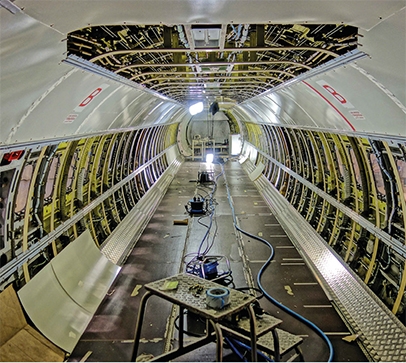Aeroconseil has longstanding expertise in the process of transforming an ATR72 into a cargo aircraft. This is a laborious and complex engineering project to implement for Maintenance, Repair and Overhaul (MRO) companies. It requires the installation of fire detection and extinguishing systems, cargo securing nets, reinforcement panels, etc. “To enhance our expertise, we wanted to have more accurate data in order to offer our customers a wider range of transformation options and technical modifications”, explained Sébastien Ayral, aircraft modification engineer at Aeroconseil. The company, based in Toulouse, France, therefore commissioned Cetim Sud-Ouest to scan and then model the internal and external components of the twenty-metre long fuselage,with accuracy to within +/- 0.2 mm.
A tight schedule
The acquisition strategy was implemented in order to comply with these requirements based on a tight schedule. Three technicians carried out their work simultaneously in the confined space of the cabin. Six days were needed to acquire millions of points using several contactless 3D measurement systems. Large 3D laser scanners were used to scan the external skin of the aircraft. This enormous amount of data was then processed using the appropriate computer software and resources: retiming of the scans in the same repository and aircraft identification, cleaning of the scatter plots in STL format then rebuilding of the surfaces. The retro-design and surface transformation process required close cooperation and many discussions with the Toulouse-based company in order to create a 3D model that met its requirements. A few weeks later, Aeroconseil had volume and surface files in Catia V5 format representing the internal and external structure of the ATR72 in great detail: rivets, stringers, frames, cable harnesses, aircraft skin, etc.



